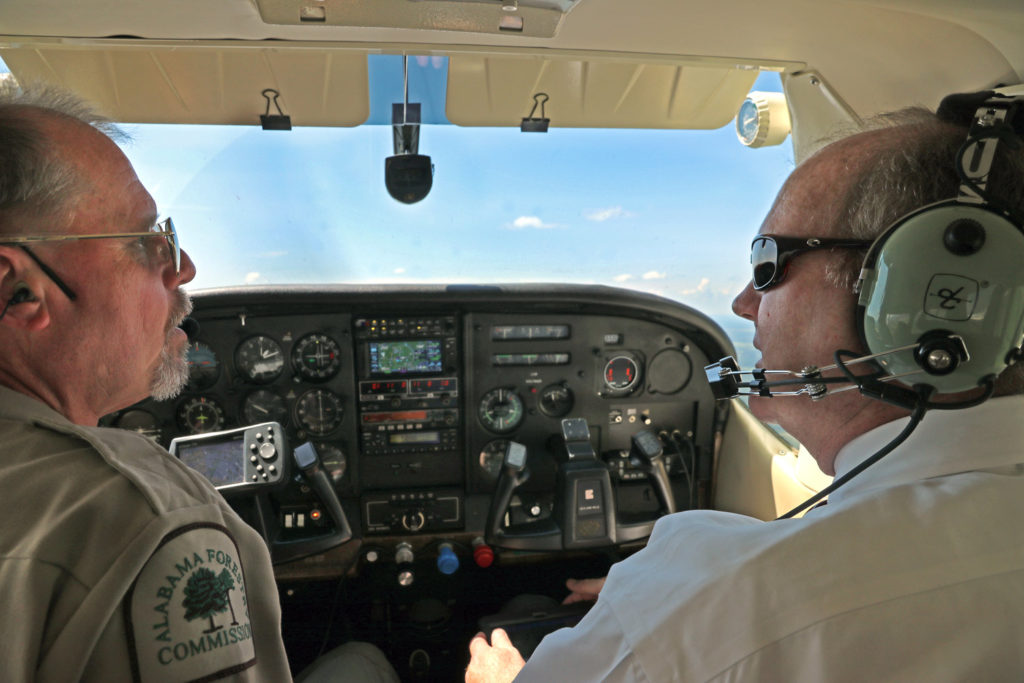Battling A Barrage Of Beetles: Tiny Bugs Attack Alabama’s Largest Industry

By Debra Davis
Slamming the door to the Cessna 182 RG, pilot Phillip Montgomery yells, “Contact!” and cranks the plane on a scorching summer day. Building speed as he heads down the Montgomery Aviation runway, he’s soon soaring 1,000 feet above a sea of green scanning for signs of a pest no bigger than a grain of rice.
It’s not long before he spots his targets — trees damaged by southern pine beetles.
“With healthy trees, you’d pretty much see solid green,” said Montgomery, an Alabama Forestry Commission (AFC) pilot. “Light green, yellow and reddish-colored trees really stand out from the air and are proof beetles are killing them. We mark the spot with a GPS, and a local forest ranger notifies the property owner. We recommend they cut the trees before things get worse.”
It’s been a busy year for Montgomery and other AFC pilots.
Last year’s drought stressed trees throughout the state, making them more susceptible to southern pine beetles, Montgomery said. The aggressive tree killers are native insects that predominantly live in the inner bark of pine trees.
The beetles feed on tree tissue under the bark and effectively girdle a tree, causing its death, said State Forester Rick Oates.
“Damage from southern pine beetles is growing in many areas of the state with more than 2,060 spots recorded this year, compared to less than 700 last year,” Oates said. “It’s an epidemic in Montgomery County. By the time pine trees change color, they’re under attack and dying. Trees can’t be treated since the beetles are under the bark. The only option is to cut down affected trees and make a buffer around them.”
Forestry is Alabama’s largest agricultural industry and covers 23 million acres — about 69 percent of the state -— Oates said. Forests generate over $21 billion in timber production and processing revenue and provide over 122,000 jobs to Alabamians.
Southern pine beetles are the primary killers of pines in Alabama, with unmanaged and overcrowded stands of southern pines most susceptible to attack, said AFC Forest Health Coordinator Dana Stone. Epidemic populations of beetles occur periodically. If not controlled, they can devastate entire forests, causing millions of dollars in damage.
The AFC urges landowners to monitor property for signs of damage and contact their local AFC office or registered forester for management recommendations before taking action.
With timber prices already low, finding a logger who’ll cut damaged timber can be difficult, Montgomery said.
Jeremy Brown who lives in south Montgomery County said family land around his farm is infested, and timber is being harvested for a fraction of the price it would normally bring.
“Timber can be a 30- to 50-year investment, and something like this can really hurt, financially speaking,” Brown said. “Timber that might have brought $1,500 an acre may bring only $200 an acre if beetles are in it.”
Mother Nature could reduce beetle numbers this winter.
“The best thing we can hope for is a cold winter to kill back the beetle population,” Oates said. “Until then, we’ll keep searching for beetle outbreaks and encouraging landowners to cut infested trees.”
Visit Forestry.Alabama.gov for more information.
